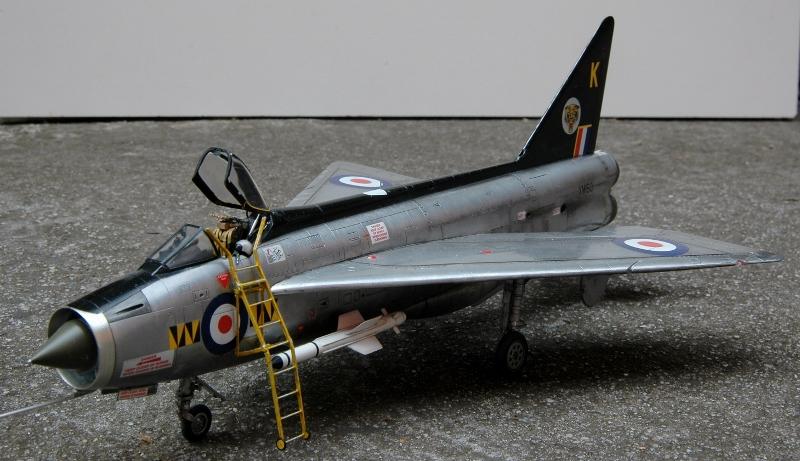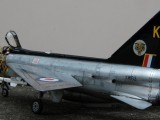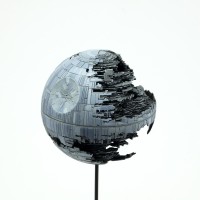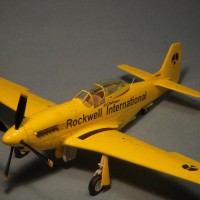My "Frightning"
Here is my attempt at reproducing the magnificent E.E Lightning F.1. The "Frightning" as it was often called by it's pilots, is one of my all time fav jets.
This is the Airfix 1/48 kit which is probably the most accurate F.1 around, but not easy to put together. I complicated the build by using the Aires wheel wells and exhaust cans. The wings were shaved almost see through to get the wheel wells in! I am glad though I made the effort.
Paint used was polished aluminium Alclad over gloss black. I "tarnished" the polished aluminium finish as it looked like a toy at first. I used aluminium "metaliser" paint semi-dry brushed - kinda worked. Raw umber/Panes Grey oils were used to show fuel, hydraulic leaks and exhaust/dirt grime.
The aeroplane represents a RAF 74 "Tiger" Squadron bird - circa 1962. Check out this video on Youtube for a "Frightning" thrill!







Beautiful work! Your NMF is outstanding.
Yet another stellar example...I sure hope you don't have a whole roomful of these outstanding builds. Your workmanship is "above and beyond". Nice work, sir.
Thanks awfully ol' chap! Thought I'd inflect that accent given the topic! Did you watch that Youtube Lightning promo? It's fantastic! It's 74 Tiger Sqdn as well - the first RAF squadron to operate the Lightning.
Don't worry, I don't have a room full of models - they take too much time to build. I only average one model a year I guess.
Very realistic NMF work on this model.
Great work on the model and yes, this was a frighteningly amazing aircraft. After Wikipedia:
"The Lightning possessed a remarkable climb rate. It was famous for its ability to rapidly rotate from takeoff to climb almost vertically from the runway, and would maintain a constant climb rate of approximately 20,000 ft/min until reaching the tropopause, 36,000 ft. on a standard day. Later on, pilots who flew both the Lightning and the F-15 described the latter as "almost as good".
Early models had a rated top speed of Mach 1.7 at 36,000 ft in and 650 KIAS (Knots Indicated Airspeed) at lower altitudes. Later models, reached a rated top speed of Mach 2.0 at 36,000 ft, and speeds up to 700 KIAS for “operational necessity only". As speed increased, the Lightning's directional stability decreased; there were potentially hazardous consequences in the form of vertical fin failure if yaw was not rapidly counteracted by correct rudder use. Stability was protected by imposed Mach limits during missile launches; later Lightning variants featured a larger vertical fin which gave a greater stability margin during high speed flight. Supersonic speeds also threatened inlet stability, which could result in engine flameout and/or damage. The shock cone was also susceptible to fatigue caused by excessive heating in high-speed flights. The stability limits and shock cone thermal/strength limits made such speeds risky. etc. etc."
I have a nice DVD on the Lightning and there are pilot interviews, one being the ex-CO of 74 Sqn. He related that many pilots were so behind the aeroplane on first flight (there being no two seater initially) and many found themselves supersonic at 20k feet before they caught up with the aeroplane mentally!
I also love the story of "Taffy" Holden who as a RAF Engineer, accidentally took off in a Lightning (a ex-74 Sqn machine) without a canopy and the gear locked down and the ejection seat pinned! Incredible story! Taffy had not jet training at all and had never flown a Lightning! Here's his story.
In attempting to write a more detailed personal account of my unfortunate flight in Lightning XM135 back in July 1966, I think I should add some of the reasoning and reason why I attempted the test in the first place. This might remove some of the erroneous facts, misapprehensions and misconceptions which I have seen in some accounts of the event.
First I should explain that I was a qualified pilot, even although I was an R.A.F. Engineer Branch officer. I joined the R.A.F. as an apprentice in 1943, from where I gained a cadetship to university. At the university I read mechanical engineering and learnt to fly on Tiger Moths, with the University Air Squadron. On graduation, I was given the option to continue with an engineering career or to follow a General Duties (Flying) career. I chose the former path and the Air Ministry at that time, considered that there was merit in allowing me to qualify to ‘wings’ standard as a pilot, in the belief that an engineering officer with a pilot qualification, could more easily see the pilots point of view in aircraft maintenance matters. I too, thought this was a very good idea.
I qualified on Harvards, but my early engineering duties only allowed me to keep in flying practice on Chipmunks. Whilst I was at Kinloss, I managed to get checked out on Oxfords and on occasions assisted a qualified test pilot, to air test twin engine Neptunes. My only jet aircraft experience was as a passenger in the second seat of a Javelin T3 and again in the ‘rumble’ seat of a Canberra. In my service, one of my postings took me to 33MU Lyneham where as the C.O of a civilian manned aircraft storage unit, I had Canberra, Meteor and Lightning types, which were gradually being prepared for despatch to various flying unit tasks. When the Meteor and Canberra types had been cleared, the powers that be, decided that the MU should close after the last Lightning’s had been despatched. Up until the last Canberra, I had a qualified and current test pilot on my staff for those aircraft, but he was not a current Lightning pilot. When a Lightning needed test flying, I had to call for any available pilot with a current test pilot rating. Most times I would find one who could be spared within a 24 or 36 hour period. So much for my personal and R.A.F unit background.
Lightning Mk 1A XM135
XM 135 was being prepared for despatch to a Target Facilities Flight, but over a period of weeks, it had been giving no end of trouble. Each time it was being flight tested, the pilot found that on the initial few yards of a take off run, the inverter, supplying power to the primary flight instruments, would cut out and the stand by inverter would have to cut in, clearly an unsatisfactory state of affairs. Electricians were using every trick in their trade to establish the cause, each time thinking that they had removed, replaced and tightened every likely component. With nothing out of order, they would seek another test flight. It was a Boscombe Down pilot who next attempted to fly the aircraft, found the same problem persisting and refused to fly until a more positive explanation could be determined.
Back to the drawing board, electricians decided to devise some tests which might isolate the fault and indicate roughly where and which component was at fault. They intended to ask the next test pilot to switch in and out parts of circuits, using trailing wires from the likely circuits to temporary switches in the cockpit and to do these electrical switchings before and after each few yards of a simulated take off run, when the fault was manifest. The temporary wires from internal circuitry required the cockpit canopy to be removed and in this state the aircraft was made ready for another air test. Being a pilot, it was easiest for me, as CO, to request the services of a qualified test pilot, from wherever I could find one, but for the next test on XM135, no pilot was available for at least another week. With my unit closing down, many civilians being made redundant, a timetable of clearance being upset with this ‘rogue’ aircraft, there was much tetchiness and irritation amongst my staff. The intended Boscombe Down pilot, knowing I was a pilot, suggested I might try the test myself. He suggested using an out of use runway (Runway36) as I would only be using 30 or 40 yards at a time. He suggested using a Land Rover to communicate with Air Traffic Control and to get their clearance for each movement of the aircraft. However, there was one remaining minor problem. I had only sat in a Lightning cockpit once before and I had no idea how to start its two Rolls Royce Avon engines! The Foreman of engine trades gave me a 5 minute briefing on how to do this and XM135 was towed out to Runway 05 on 22July 1966 for my electrical tests.
It was by way of extraordinary good fortune that my engine Foreman explained that, although I would not be needing reheat, that reheat needed the throttles to be pushed past a reheat ‘gate’ and one had to feel for the gate keys, behind the throttle, to unlock. My only other knowledge of the Lightning was what I could remember from pilot’s notes. At each test flight by the qualified pilot, I would be in ATC with a copy pilot’s notes, should he need any aircraft figures to be relayed to him. One or two figures stuck in my mind, namely that the undercarriage had a maximum speed before it should be retracted and I had an even vaguer figure of about 150 knots for a landing speed. Some extra knots would be required for each 1000 lbs. of unused fuel, but I did not need to bother with any such figures for the test, which I was to undertake.
The Ground Test
I was correctly strapped into the cockpit (seated on the in situ parachute and ejector seat) and after starting the engines and holding the aircraft static, on the brakes, I did the necessary preliminaries for the electrical checks in the cockpit, checking the notes I had scribbled on a notepad which lay on the coaming in front of me. All seemed ready for the first test and I indicated to the Land Rover to obtain ATC clearance for use of the short 30 or 40 yards of runway. Holding the brakes I gradually opened the throttles to about 90%. My feeling at the time was the unexpected heavy vibration of Avon power held against the brakes. I did a quick check of the temporary electrical switches and circuitry lights, then released the brakes. That initial punch from the thrust was quite remarkable and I moved the expected 30 to 40 yards before I throttled back and applied the brakes. So far so good. I made some notes, altered some more switch positions, noted the on/off lights and prepared for the next test. This was done in a similar fashion and I was leaving the ‘fault’ diagnosis to my electrical staff who would have to interpret my notes. I needed to do one more test and ATC had noted that I had only used about 100 yards total, so they were quite happy to clear me for a similar short distance. ATC had also been holding up a fuel bowser and trailer with 3600 gallon of AVTAG for awaiting C130 aircraft refuelling, they decided to allow the bowser to cross the runway. On opening the throttles for that final test, I obviously pushed them too far, misinterpreting the thrust, because of the unexpected heavy vibration and they got locked into reheat. Yes, I did use some expletives but I had no time to think of getting out of reheat, because in front of me, the bowser and trailer had just crossed the runway, from right to left, so my thoughts were to make sure I was missing them by sufficient margin. No, I couldn’t steer to clear them; reheat takes you in a straight path like a bullet out of a gun. The time between finding myself in reheat and just missing the bowser was less than half the time I have taken to write this sentence.
Before my thoughts could again return to getting myself out of reheat, I was gathering speed and about to cross the main duty runway, where a Comet had just passed on its take off run. I then had no time to look for reheat gate keys, my eyes were on what next lay ahead. Two things, the end of the short runway 07 and just beyond was the small village of Bradenstoke which I just had to miss. There was no chance of stopping, non whatsoever. I had gained flying speed (that is what reheat is for, short sharp take offs) and I had no runway left. I did not need to heave it off the runway, the previous test pilot had trimmed it exactly for take off and only a slight backward touch on the stick and I was gathering height and speed. Then my thought was to get my speed back in case I should damage the undercarriage. Incidentally, I could not have raised the undercarriage; the ground servicing locks were in place for safety reasons. With only clear blue sky in front of me, I could then search and feel for those gate keys. Yes, I found them and thanked my lucky stars that my engine foreman had quite incidentally told me of their location and I was soon able to get the speed back to (I am guessing now) about 250knots. My next thoughts were to keep Lyneham airfield in sight and where had the Comet got to, the one I had missed a few seconds ago? Then I asked myself, should I eject and where and when? No, I could not; the safety pins were in the ejection seat and safe for servicing, not for flying. My only alternative then was to attempt a landing, but how does one interpolate or extrapolate Tiger Moth, Chipmunk, Harvard flying to a two engined, 11 ton, beast like the Lightning?
After regaining my bearings, a little composure and simply by observation, making sure that the Comet had been warned away, I decided I should attempt a landing on the duty runway and direction. I was trying to combine all my limited flying experience into a few minutes of DIY flight ‘training’ on a Lightning. It wasn’t easy, but I must admit that some of the elementary rudiments of my proper flying training and flight theory were coming in useful. I needed to get the feel of the aircraft, if I was to get it back on the ground. My first approach was ridiculous, I could tell that my speed, height, rate of descent, even alignment wasn’t correct and my best plot was to go round again. This time making sure that my throttles would be well below reheat position. A second approach was no better, I had some aspects better, but as the duty runway 25 is on the lip of an escarpment, with a valley floor beyond, my rate of descent took me below runway height and I found myself adding power to get back to the right level. More power also meant more speed and I was trying to get to something like 150 knots for landing, but the uncoordinated attempt was becoming a mess so I abandoned it, took myself away on a very wide circuit of Lyneham and decided to land in the opposite direction. This I thought would give me more time to get the ‘feel’ right and if I made a mess of the landing, I would overrun the runway and just drop (crash) into the valley beyond. In that direction, with a messed up landing, I would have no fear of crashing into Lyneham village.
The long final leg of this approach gave me the thinking time that I needed and I gradually got the feel that speed, alignment, rate of descent, height and approach angle were better. I plonked it down at about the right position off the runway threshold, but just forgot that I was in a nose wheel aircraft and emulated my best three wheelers in a Chipmunk or Harvard. The result was that I crunched the rubber block which encases the brake parachute cables. However, I had got down, but I then had to stop. I obviously knew the Lightning had a brake parachute, but where was the ‘chute lever, button or knob? There, I found it marked Brake Chute and I pulled it and I could then look ahead and concentrate on keeping straight and somewhere near the centre line. I hung on to the brake lever, I wasn’t slowing as much as I would like, so I just kept up my hand pressure on the brakes. I had about 100 yards of runway left when I stopped and even then, I didn’t know that the brake parachute had dropped off as soon as it was deployed, because the cable had been severed as a result of my super tail wheel three pointer.
Events Immediately after the Flight
XM 135 was towed back to the hangar and I was taken to see the medical officer who gave me some pills to calm my nerves. I felt reasonably calm because I had almost killed myself on five occasions in that 12 minute flight, yet I had miraculously survived. What is more, I would see my wife and young family again. Two or three times in that same 12 minutes, I thought I would never ever see them again. My only priority was to save my own skin, I was not thinking about the non insured loss of a Lightning Mk 1A aircraft. The minor damage to the aircraft was repaired with a new set of brake shoes and a new rubber chute block. As a memento, I have kept that rubber block, one day it might be returned to XM135 at Duxford.
The Fault
Although the tests I did and the ensuing flight did not immediately provide a reason for the initial electrical fault, my electrical staff, with additional assistance from English Electric, Salmesbury eventually did. Apparently, in early versions of the Lightning, there was to be a ground test button fitted into the standby inverter circuit. It was never fitted to the Mk1A but the wires were left in the looms. It was one of these redundant wires which shorted on to the UHF radio as it moved on its trunnions when the aircraft nudged forward on take off. Who would have thought I should risk my life to find it, in the way I did?
Events Subsequent to the Flight
There was a subsequent Inquiry to find out what had happened and why and to make recommendations for it never to happen again. As I was the Commanding Officer of the Unit, I was responsible for my own as well as the service actions of all my staff. I was not acting against any orders in the Flight Order Book which I religiously kept up to date. But those orders did not cater for engineering officers doing investigative type checks on Lightning’s. They were later amended. After the Unit Inquiry I had to go up in front of the Commander-in-Chief. That was when I thought my career would be placed in jeopardy. I even thought that my coveted ‘wings’ would be taken from me; I had no idea how the incident was being regarded by Command or indeed Air Ministry. But, as I stood in front of Air Marshal Sir Kenneth Porter, he read the proceedings, asked me if I agreed with his view that "With the limited flying experience that I had, the test would have been better left to an experienced and current Lightning test pilot." I agreed of course. He then told me to remove my hat, sit down and proceeded to tell me some of his unfortunate flying incidents in Mesopotamia in the Middle East. I was thankful that nothing more was to become of the incident and that I still had a job to do back at 33 Maintenance Unit, Lyneham.
I coped with all the official communications regarding the incident, but what I was unprepared for was the release of the story to the public. I had had very little experience of working with the press, certainly none with radio, TV, national and world press. I had no training in how to deal with their quest for news. My Command Headquarters suggested I went away on leave before press releases were made by Air Ministry. This I did and took my family off camping to Jesola, in Italy. Imagine my complete surprise when, on the first day of camp, on my way to find some ice, someone shouted “Hello Taffy, I’ve just been reading about your Lightning flight!” The world seemed a very small place. On returning to the U.K. I was overwhelmed to find that the incident was still front line news. People wanted to write articles in newspapers, books, magazines, interviews on TV and radio and underhand attempts to hear my account of what had happened. Having admitted that I had made an unwise decision to do the ground tests, I decided that the unwanted publicity that I had attracted was in no way going to be for financial gain. I steadfastly refused offers although for a two page article in the Sunday Express, I requested the editors to make a contribution to the R.A.F. Benevolent Fund. Despite prompts, no moneys were ever handed over and I became very disillusioned with all publicity media. Some friends thought I had gained reward for an article in ‘Mayfair’; it was written without my knowledge and authority, but, because it was factually correct, I had no redress from the Press Complaints Board. Nonetheless, I was extremely annoyed.
Some years after the incident, my hidden fears of high speed flight came to the surface and I had to spend two periods in hospital. I had not come to terms with the emotional side of the event. To return to my wife and family after five close encounters with death, was indeed a miraculous experience, but I had not been honest with myself, to accept it as such, so I needed psychiatric help. I could recall the technicalities of the flight without any hang-ups, but was unwilling to talk about that emotional side of the ordeal until I was placed under medical drugs and to bring those emotions to the surface. That was a rewarding experience and it gave me a much better understanding of people who might need that same kind of help, after similar unfortunate occurrences.
Forty Years On
I am now retired and living with my wife in Cheshire. Apart from being an active DIY plumber, carpenter, electrician handyman, my main pastime is involvement with family history. My inadvertent flight is still very vivid and in writing this personal account, I needed little prompting. Over the intervening years, I have received many letters and reminders from people whom I did not know, all praising my efforts to return myself and aircraft back to the ground safely. Yes, I have basked in some glory, when accounts of what happened, have been retold in social gatherings. I have never sought publicity, but whenever it became impossible to suppress, I have had to live with it. I enjoyed my career in the Royal Air Force, but not because of XM135!
Best regards
Taffy Holden
Great job on that beast! I love the NMF and the realistic weathering. This is one of my favourite aircrafts and you made a fantastic work on it.
Congratulations.
Nice looking Lightning! The plane itself can be deceptively difficult to build with respect to getting the alignment right.
I assume you know about the fellow in Japan who built one a few years back. He primed it with gloss black, sparayed it with Mr. Color metallic silver with a hint of black added, and then drybrushed the model with chrome silver. I'd say its probably the closest thing to achieving a bare metal finish outside of using foil.
Great choice of markings. Has sort of an understated elegance to it.
Thanks for your kind comments. Yes, it's a bast@rd to put together and get aligned. Due to the severe thinning of the wings to get the Aires wheel wells in, my wings warped terribly when the super glue set. I was about to hurl the model at a scaled Mach 1.7 at the wall! I was able to stress relieve the wings by careful twisting back into shape cracking the super glue and then re-glueing - very lucky!
Interesting technique with that Japanese modeller - I did the reverse - starting with a very shiny finish (as these 74 Sqn aeroplanes were display birds and polished) and then "tarnished" by dry brushing a duller aluminium metaliser. Next time I will dab using a small sponge as well. NMF is so hard to get realistic! I would use foil on a 1/32 build.
Very nice Lightning! I like 74 Sq. aircraft.